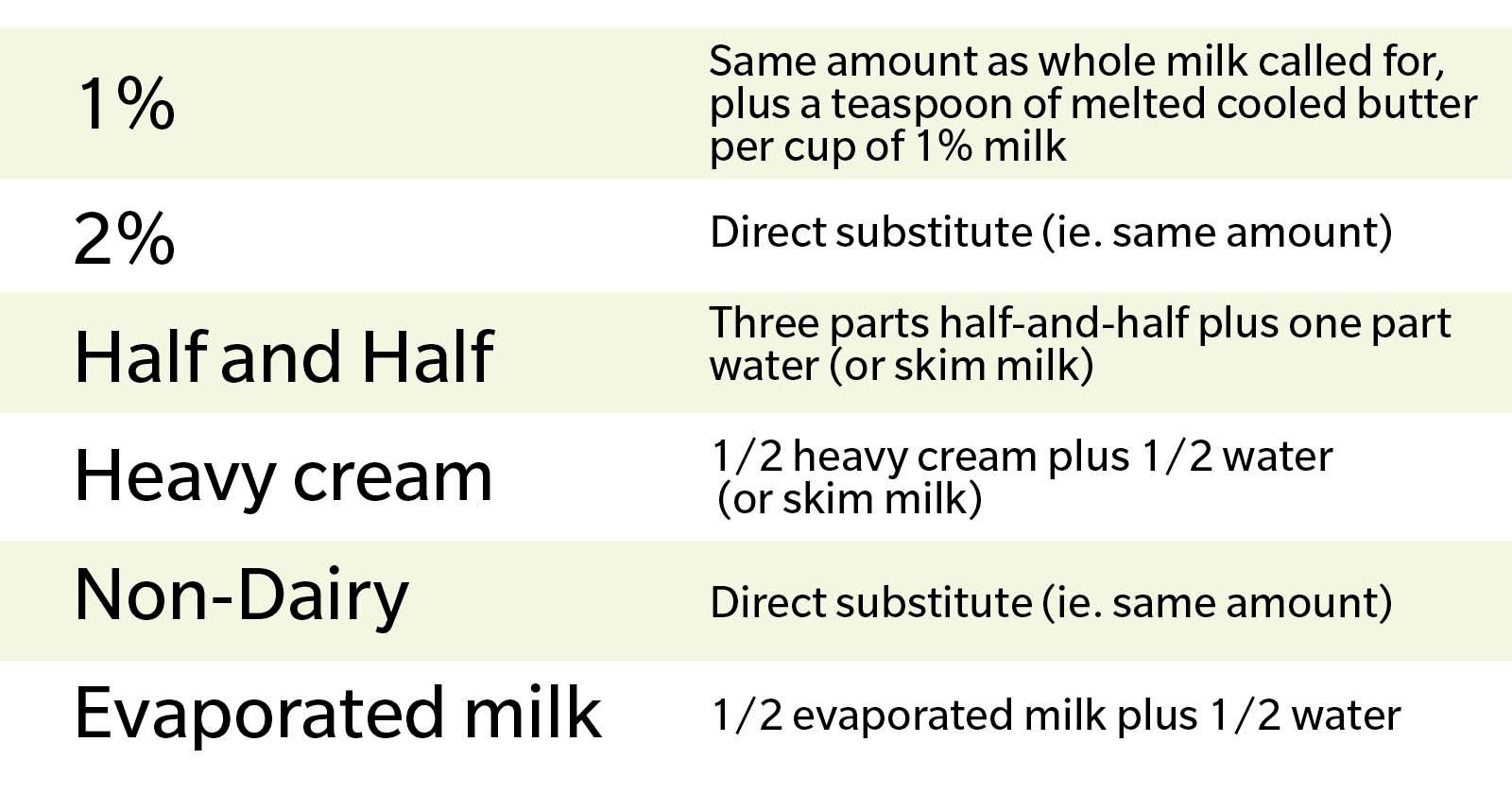That gallon of whole milk is the Goldilocks of dairy. It’s not too fatty, nor too bland, but just right for lending flavor and texture to anything it touches. And it’s something (like eggs) most of us usually assume is stocked in the fridge—until you’re mid-recipe and realize you’re fresh out.
Here are more quick baking substitutions you need to know.
What difference does using a milk substitute make?
Most milk has had its natural fats removed and then replaced to reach the specific levels of 1%, 2% and 3.25% (whole milk). Half-and-half comes in at around 10% fat, while heavy cream is usually around 35%. And as with most foods, for better or for worse, more fat equals more flavor.
Whether you have another kind of milk, dairy or a non-dairy substitute, you can still make that cake, sauce or pudding with a whole milk substitute. Here’s how.
6 Milk Substitutes

1% Milk
Lean but versatile
This milk, with less than half the fat content of whole milk, won’t majorly change the texture of cinnamon rolls or other yeast rolls, but it will underperform in rich cakes, sauces and puddings. If it’s all you’ve got, try using the same amount as whole milk called for, plus a teaspoon of melted cooled butter per cup of 1% milk.
If you have half-and-half on hand, mix 2/3 cup 1% milk with 1/3 cup half-and-half to make 1 cup of whole milk substitute.
2% Milk
Easy and all-purpose
If you’re a regular 2% buyer, take comfort. It may not be quite as flavorful and rich, but it’s the closest thing to whole milk and any change to your recipe will be negligible. Don’t hesitate to substitute it directly for whole milk in just about any cooking or baking recipe.
Half-and-Half
Even richer results
Good news—you can use half-and-half as a direct substitute for whole milk in many recipes. With a fat content of around 10-12%, its extra fat will add richness, but its texture won’t change things too much. If you’re reluctant to add more fat to your recipe, thin it out by mixing three parts half-and-half to one part water or skim milk.
Heavy Cream
Full of flavor
With fat content up to 36%, this substitute will definitely alter your recipe. To use it, just dilute it with water. For every 1 cup of whole milk you need, use 1/2 cup heavy cream and 1/2 cup water (or skim milk).
Nondairy Milks
Standout substitutes
Though they’re made from different sources, you should be able to use any nondairy milk in direct substitution for whole milk without altering the texture too much. Just make sure that the flavor of your substitute is something you want in the end result. For example, almond, coconut and soy milk can change the taste of your recipe.
Evaporated Milk
Ultra convenient
With a shelf life as long as a year, it’s always a good idea to keep a can or two of evaporated milk in the pantry. Not to be confused with sweetened condensed milk (here’s the difference), evaporated milk is what it sounds like: milk that’s had liquid removed from it. The result is more concentrated flavor and fat. Simply dilute your evaporated milk in order to use it in place of whole milk. To make 1 cup milk substitute, mix 1/2 cup evaporated milk with 1/2 cup water.
No matter which substitute you use, your cooking and baking will turn out just right with some minor tweaks and the right know-how.
The post 6 Whole Milk Substitutes for Cooking and Baking appeared first on Taste of Home.
Elizabeth Harris